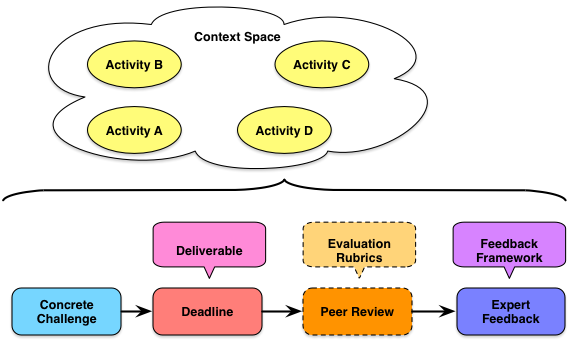In thinking through what makes experiences engaging, and in particular making practice engaging, I riffed on some core elements. The three terms I came up with were Challenge, Choices, & Consequences. And I realized I had a nice little alliteration going, so I’m going to elaborate and see if it makes sense to me (and you).
In general, good practice is having the learner make decisions in context. This has to be more than just recognizing the correct knowledge option, and providing a ‘right’ or ‘wrong’ feedback. The right decision has to be made, in a plausible situation with plausible alternatives, and the right feedback has to be provided.
So, the first thing is, there has to be a situation that the learner ‘gets’ is important. It’s meaningful to them and to their stakeholders, and they want to get it right. It has to be clear there’s a real decision that has outcomes that are important. And the difficulty has to be adjusted to their level of ability. If it’s too easy, they’re bored and little learning occurs. If it’s too difficult, it’s frustrating and again little learning occurs. However, with a meaningful story and the right level of difficulty, we have the appropriate challenge.
Then, we have to have the right alternatives to select from. Some of the challenge comes from having a real decision where you can recognize that making the wrong choice would be problematic. But the alternatives must require an appropriate level of discrimination. Alternatives that are so obvious or silly that they can be ruled out aren’t going to lead to any learning. Instead, they need to be ways learners reliably go wrong, representing misconceptions. The benefits are several: first, you can find out what they really know (or don’t), and you have the chance to address them. Also, this assists in having the right level of challenge. So you must have the right choices.
Finally, once the choice is made, you need to have feedback. Rather than immediately have some external voice opine ‘yes’ or ‘no’, let the learner see the consequences of that choice. This is important for two reasons. For one, it closes the emotional experience, as you see what happens, wrapping up the experience. Second, it shows how things work in the world, exposing the causal relationships and assists the learner understanding. Then you can provide feedback (or not, if you’re embedding this single decision in a scenario or game where other choices are precipitated by this choice). So, the final element are consequences.
While this isn’t complete, I think it’s a nice shorthand to guide the design of meaningful and engaging practice. What do you think?
 The empirical data is that we learn better when our learning practice is contextualized. And if we want transfer, we should have practice in a spread of contexts that will facilitate abstraction and application to all appropriate settings, not just the ones seen in the learning experience. If the space between our learning applications is too narrow, so too will our transfer be. So our
The empirical data is that we learn better when our learning practice is contextualized. And if we want transfer, we should have practice in a spread of contexts that will facilitate abstraction and application to all appropriate settings, not just the ones seen in the learning experience. If the space between our learning applications is too narrow, so too will our transfer be. So our